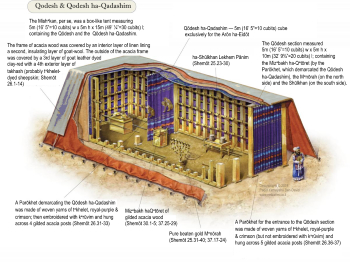
 |

So Mōsh•ëhꞋ told all of Ad•atꞋ Bᵊn•eiꞋ-Yi•sᵊrâ•eilꞋ: “This is the Dâ•vârꞋ that é‑‑ä tzi•wâhꞋ, saying,
“Accept a tᵊrūm•âhꞋ for é‑‑ä, from among each of you who volunteers from the heart, to bring a Tᵊrūm•atꞋ é‑‑ä: of gold, silver or copper;
or tᵊkheilꞋët-dyed finely-woven linen, or goat-wool, or clay-red dyed ram leather, or tᵊkheilꞋët-dyed tzōn-leather
or acacia wood; or oil for the lamp, or spices for either mi•shᵊkh•âhꞋ-oil or qᵊtōrꞋët-medicaments. Also, onyx and other gems to be set for the Ei•phōdꞋ and KhōꞋshën Mi•shᵊpâtꞋ.
“So allow every top expert in their field
to come and make all of these things that tzi•wâhꞋ é‑‑ä.
“The Mi•shᵊkânꞋ & its ŌꞋhël”
 |
 |

Optional parental preparation:
ðÀçÉùÑÆú, 35.05—While these events took place in the Bronze Age, the added expense of upgrading copper to bronze (by adding tin) was expensive and likely confined to hardened weapons. Further, copper sheeting, in addition to being simpler to produce and, hence, less expensive, is more malleable, as well as better suited to diffusing and dissipating heat from the acacia frame of the grill—most likely a primary function of the ðÀçÉùÑÆú qᵊrân•ōtꞋ extensions at the top of the four corners.)
Note, too, that copper is malleable. Handcuffs made of copper would be vulnerable to working back and forth where the cuffs are linked to the central chain, eventually breaking. The central chain itself, also made of copper, would be similarly vulnerable to twisting back and forth until it broke. ![]()
úÌÀçÈùÑÄéí (tᵊkhâsh•imꞋ), pl. of úÌÇçÇùÑ (taꞋkhash), 35.07—meaning in Biblical era unknown and widely debated. Earliest descriptions indicated only that it was a type of undefined leather, which was often specified as dyed tᵊkheilꞋët. Undefined leather, rather than European wild speculations of non-kâ•sheirꞋ imagineering–e.g., dolphin, badger or dugong–almost certainly refers exclusively to any combination of the several species widely and regularly included in the Biblical tzōn livestock herds. ![]()
Discuss the features of the Mi•shᵊkânꞋ & its ŌꞋhël
Questions you might anticipate that your child might raise and be prepared to discuss:
What does it mean to volunteer from the heart?
What is tᵊkheilꞋët-dyed finely-woven linen, or goat-wool, or clay-red dyed ram leather, or tᵊkheilꞋët-dyed tzōn-leather![]() ?
?
![]()
 |
 |